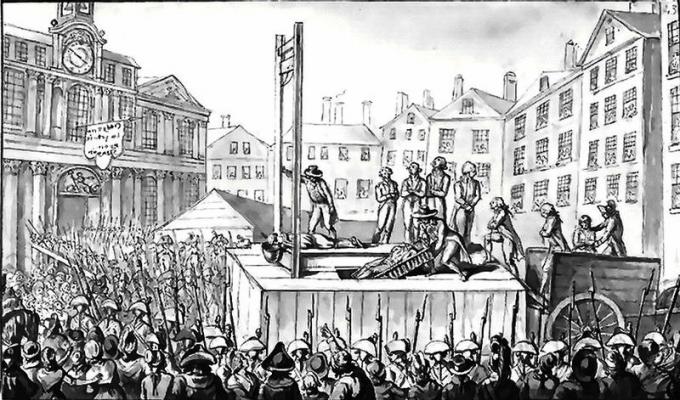THE French Revolution it was a movement initiated by the bourgeois class in order to overthrow the Ancien Régime, a period marked by social injustices. Despite having started in a higher stratum of society (but not recognized by the nobility), it had strong support from the peasant masses, small traders and liberal professionals.
One of its most radical and violent phases is today known as the Terror Phase. Marked by executions by enemies of the Revolution, it consisted of the persecution of monarchists, in addition to the Girondins by the Jacobins, the two main currents of the revolutionary movement.
What was the Terror Phase in France?
The period, knowledge as people's revolution or Radical Phase, was the most violent and radical of the French Revolution. Led by the Jacobin current, formed by the petty bourgeoisie, merchants and liberal professionals, it had the support of the poorest strata of the population.
Marked by the high number of executions, it had Maximilien Robespierre, Jean-Paul Marat and Georges Danton as great leaders. The Terror Phase lasted from 1792 to 1794, with the execution of Robespierre.

Historical context and main features
France was the greatest symbol of ostentation of the Ancien Regime, especially in the figure of King Louis XVI. Tired of the privileges of the nobility, the social injustices and little recognition of her class, the bourgeoisie initiates one of the greatest movements of political and social transformation in history, the Revolution Bourgeoisie.
Among the revolutionaries, there were two opposing currents – Girondins and Jacobins. The former sat to the right of the Assembly and were composed of the upper bourgeoisie and liberal nobles. The Jacobins, seated on the left, represented the petty bourgeoisie and defended the ideal of an egalitarian society.
The Jacobins took the lead in the Revolution in September 1792, when there was a massacre of imprisoned royalists commanded by the movement. The scenario was the result of the pretense of European monarchies such as Prussia and Austria to invade France in order to restore the regime.
The country resisted with the support of an army constituted by the poor population in order to fight the enemy that wanted to end the revolution and restore the Old Regime. In 1792, the Jacobins led a popular revolt that culminated in Louis XVI's departure from power, as well as the resignation of all ministers.
- Free Online Inclusive Education Course
- Free Online Toy Library and Learning Course
- Free Online Math Games Course in Early Childhood Education
- Free Online Pedagogical Cultural Workshops Course
In September of that year, the National Convention was established with the aim of modifying the country's laws. There, the conflicts of interest between the two revolutionary currents began – Girondins and Jacobins. They even declared King Louis XVI guilty of treason, condemning him and his wife, Marie Antoinette, to the guillotine.
Also at the Convention, the Jacobins led by Robespierre adopted popular measures, such as the abolition of privileges, an end to slavery in the colonies, price fixing of products considered essential, division of large properties, in addition to compulsory and free education, as well as help to destitute.
The Jacobins suspended the Constitution and created the Committee for Public Safety and the Revolutionary Court. Obviously, such actions aroused the wrath of the Girondins who organized to then persecute, arrest and murder Jacobins. The Assembly appoints the Committee of the Twelve to control the Paris Commune and prevent excesses.
The reaction on the other side was even more violent when it concluded that the defense of the Revolution depended on the elimination of all its opponents. In 1793, there was the execution of royalists, Girondists and rich bourgeois. The organization called sans-culottes surrounded the Assembly and forced the Convention to arrest the entire Girondin bench.
The Convention and the Court were both conductors of the policy of terror, ordering the arrest and trial of those considered to be traitors to the Revolution. Initially, 22 Girondin leaders were arrested and killed. Thousands of people were executed by the national guard.
The executions were completed at the behest of the Jacobins and even included the chemist Lavoisier. In 49 days, Robespierre, who had concentrated dictatorial powers, sends 1,400 people to the guillotine in just 49 days. The problem is that the Commune began to persecute members of the Jacobin current itself.
The Terror started to execute enemies, like Herbert, and allies, like Danton himself, supporter of Robespierre. Accused of conspiring against the Regime for defending more moderate positions, he was judged without the right to defense and sentenced to death. Before being guillotined, however, he asked the executioner to show his head to the people.
The fear of death hovered over the Jacobins who then revolted against their leader. The following year, the group led by Robespierre lost the support of the current itself, precisely because of the violence adopted. The consequence was their domination by the Girondins, from the moment they lost military support.
In the end, Robespierre was arrested and guillotined on July 28, 1794, through the Coup of Thermidor, which removed him from the presidency of the Committee for Public Safety (created by him). The Terror Phase of the French Revolution was coming to an end. The balance of this period was bloody – 65,502 deaths by the Jacobin government.
Also check:
- French Revolution
The password has been sent to your email.


